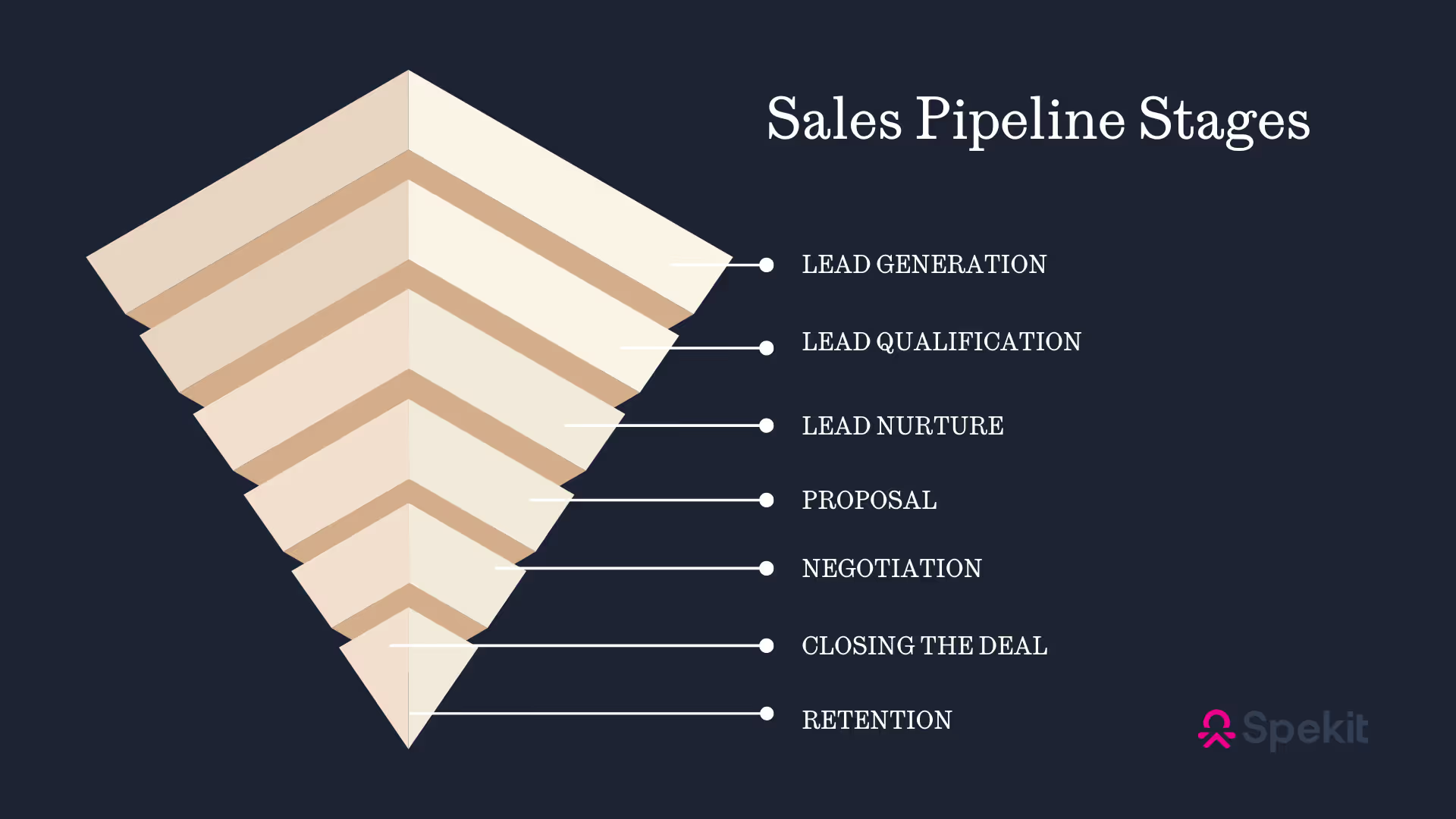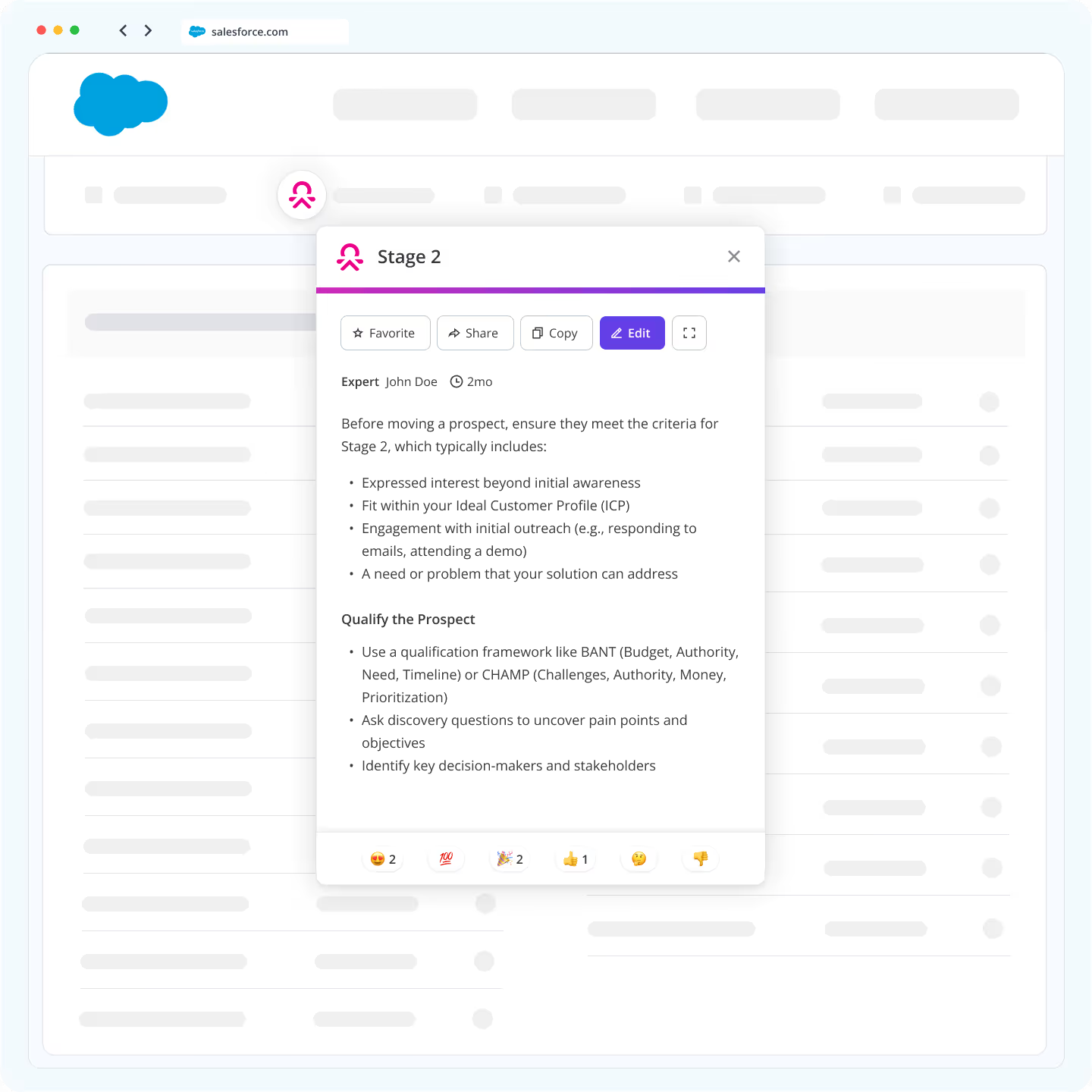Is your sales team speaking the same language when it comes to pipeline stages?
When sales leaders and reps interpret deal stages differently, forecasting becomes impossible, data loses meaning, and revenue suffers.
Inconsistent pipeline stages undermine accountability, prevent accurate diagnosis of performance issues, and make hitting targets nearly impossible. With 84% of sales reps missing quota last year, B2B sales teams can't afford the confusion.
This article will review the 7 sales pipeline stages that modern B2B and SaaS companies use to structure their pathway building pipeline and smashing revenue targets.
What is a sales pipeline stage?

Documenting and aligning on a sales pipeline (and getting your CRM properly setup) can help sales teams prioritize their efforts, forecast revenue, and identify bottlenecks in the sales process.
This also provides management and team members with a clear view of the overall health of the sales operation.
The 7 sales pipeline stages explained
Below are pragmatic definitions, exit criteria, and in-the-flow guidance to keep stages consistent in your CRM and consistent in practice.
1. Lead generation or prospecting
Lead generation is the initial stage of the sales pipeline. It involves identifying and attracting potential customers who have shown some degree of interest in your product or service. Leads can come from various sources, such as marketing campaigns, website inquiries, referrals, or networking events.
Key activities in lead generation:
- Inbound Marketing: Creating compelling content, running online ads, and optimizing your website to attract potential customers.
- Outbound marketing: Proactively reaching out to potential leads through cold calls, emails, or direct mail.
2. Lead qualifying
Not all leads are equal; some are more likely to convert into paying customers than others. Lead qualification involves assessing the quality and potential of each lead to determine if they are a good fit for your product or service. If the lead has a genuine interest and the necessary budget, they move to the next stage with a higher probability of the deal closing.
Key activities in lead qualification:
- Scoring leads: Assigning scores based on factors like budget, needs, authority, and timeline (BANT).
- Lead profiling: Gathering information about the lead’s organization, role, and pain points to gauge their suitability.
3. Contacting & lead nurturing
Once you’ve identified and qualified leads, the next step is to engage them. This involves building relationships, providing valuable information or resources, and addressing questions or concerns.
Key activities in contacting & lead nurturing:
- Personalized communication: Sending targeted emails, making phone calls, or scheduling meetings to discuss how to tailor products to meet your audience’s needs.
- Providing value: Sharing educational content, case studies, or product demonstrations to showcase the benefits of your offering.

4. Proposal
As leads become more interested, you’ll enter the proposal stage. Here, you present a formal proposal outlining your product or service, including pricing and terms.
Key activities in proposal & negotiation:
- Creating proposals: Developing detailed proposals that address the lead’s specific needs and concerns.
5. Negotiation
You’ll now enter the negotiation stage. At this stage, leads may seek customizations or discounts.
Key activities in proposal & negotiation:
- Handling objections: Addressing objections and concerns the lead may have, offering solutions or compromises.
6. Closing the sale
This is where the deal is won, lost (or put on hold). The prospect accepts the proposal and becomes a customer–or decides not to proceed.
Key activities in closing the sale:
- Obtaining commitment: Ensuring the lead is ready to proceed and facilitating the signing of contracts or agreements.
- Handling final details: Addressing any last-minute questions or concerns, arranging for payment, and setting delivery or implementation dates.
7. Post-sale follow-up
The sales process doesn’t end with the sale; it continues with post-sale follow-up. This stage focuses on ensuring customer satisfaction, building loyalty, and potentially generating referrals or repeat business.
Key activities in post-sale follow-up:
- Customer onboarding: Helping the customer get started with your product or service and addressing any initial questions or issues.
- Gathering feedback: Seeking feedback from the customer to identify areas for improvement and assess their overall experience.
What is pipeline progression?
Pipeline progression tracks how potential deals move through your sales process, from initial contact to final conversion. Let's look at a practical example:
In a recent quarter, a B2B software company tracked their pipeline:
- 150 leads entered the pipeline
- 120 qualified (80% conversion)
- 85 reached proposal stage (71% of qualified)
- 42 entered negotiations (49% of proposals)
- 28 closed successfully (67% of negotiations)
This data reveals that the company converts 19% of leads to customers overall, with the most significant drop occurring between proposal and negotiation stages (51% loss).
The average deal spent 18 days in the proposal stage—longer than their 12-day target.
This analysis helps identify exactly where to focus improvement efforts: shortening the proposal stage and preparing sales teams to better address objections that prevent deals from advancing to negotiation.
Tracking these metrics regularly allows you to measure the impact of process changes and make more accurate revenue forecasts based on your pipeline's health.
Why do you need sales pipeline stages?
Here are the real-world benefits of creating a meticulously planned sales pipeline instead of just having a messy sales CRM.
1. Faster growth rates
A well-defined sales pipeline provides a structured roadmap for sales managers and reps to nurture leads, find opportunities, manage sales collateral, and optimize sales processes to achieve set outcomes.
Clear pipeline visibility gives sales managers time to effectively plan their sales strategies, taking note of how to shorten sales cycles, reduce bottlenecks, measure sales reps' success, and forecast revenue. This tight planning allows the sales team to work effectively toward achieving set goals and hitting quotas, activating faster and sustained business growth.
2. Shorter sales cycles
With a sales pipeline to guide the sales team on what financial and non-financial goals to achieve it helps them work more efficiently, resulting in shorter sales cycles. The sales pipeline gives visibility into the sales cycle and makes it easy to identify issues slowing down the cycle and room for sales acceleration.
The pipeline can help them answer questions like what aspect of the sales team is weak and needs more effort, what sales enablement tools are needed to optimize workflow, or which prospect would be difficult to convert but bring higher revenue.
This proactive approach enables them to streamline the sales process and plan around issues that may slow down the cycle, allowing them to push leads faster through the pipeline and shorten sales cycles.
3. Helps forecast revenue & cash flow
According to Forbes, businesses are 10x more likely to grow their year-over-year revenue with an accurate sales pipeline. A sales pipeline is a great revenue and cash flow forecasting tool that allows you to visualize leads, how long it would take to close them, and the potential value of each lead.
With data insights from prior closed sales, prospect behavior, and industry trends, you can estimate which leads will likely convert and when. This enables you to accurately determine monthly revenue and set KPIs, sales performance metrics, and outcomes.
4. Reduces sale process bottlenecks
A sales pipeline helps sales managers easily identify bottlenecks that will slow the sales cycle, such as excessive back and forth with a prospect, stalled deals, or unnecessary time spent on certain tasks. With these insights, they can determine how to streamline sales processes, allocate resources, and provide extra support to sales reps.
A common bottleneck is sales reps spending a lot of time searching for sales content. A sales pipeline can provide visibility into this problem and allow sales managers to plan for it by implementing a content management system like Spekit’s that enables sales reps to access and surface sales content in their workflow whenever needed.
5. Insights into sales rep successes
Sales reps are at the forefront of every business and are given actionable goals that are difficult to measure. For example, relationship building with clients and prospects is an important part of a sales rep's job, but quantifying the impact of those relationships on sales outcomes is hard.
With a sales pipeline, however, you can tie relationship building to the sales end goal and attach timelines to track whether a sales rep's customer relationship management has converted or turned a lead into a recurring customer. A robust pipeline also gives reps actionable and measurable insights into their activities to determine which leads will likely convert and prioritize high-value sales opportunities.
This will help sales reps achieve goals and quotas consistently and provide a way for you to track their progress.
SaaS sales pipeline stages example
Let’s take a look at how the sales pipeline stages might work in a SaaS business.
1. Lead generation or prospecting example
Let’s say you run a SaaS company that offers project management software tailored for large enterprises. You identify potential leads by attending industry conferences, running targeted LinkedIn ad campaigns, and collecting inquiries through your website’s “Request a Demo” form.

2. Lead qualifying example
You receive inquiries from various sources. To qualify leads, you have a set of criteria, such as the company’s size, budget, and specific pain points related to project management. Leads that meet these criteria are considered qualified.
3. Contacting & lead nurturing example
After qualifying a lead, your sales team reaches out to schedule a demo. During the demo, they showcase how your SaaS solution can address the lead’s specific project management challenges. They also provide educational content like case studies and whitepapers to nurture the lead’s interest.
4. Proposal & negotiation example
The enterprise client is interested in your SaaS solution and requests a formal proposal. Your team creates a detailed proposal outlining the pricing structure, customization options, and implementation timeline. Negotiations may occur around the pricing, contract terms, or specific features the client needs.
5. Closing the sale example
After successful negotiations, the enterprise client agrees to move forward with your SaaS solution. They sign the contract, and the sale is closed. The client may provide an initial payment or schedule payments according to the agreed-upon terms.
6. Post-sale follow-up example
The sale isn’t the end of the relationship. You continue to provide support, onboarding assistance, and regular check-ins to ensure the client’s successful adoption of your SaaS solution. This post-sale follow-up is crucial for customer satisfaction and potential upselling or referrals.
This is the stage when you get to maximize customer loyalty, retention, and CLTV.
How to build your sales pipeline
A well-structured sales pipeline is essential for optimizing your sales methodologies and achieving revenue goals. Here are best practices for setting up and managing your sales pipeline effectively:
1. Determine your revenue & sales goals
Having specific goals that align with your company’s broader objectives provides clear direction for your sales team with relevant and measurable targets. It also guides allocating human and financial resources and helps prioritize leads and opportunities in your pipeline.
- Specificity is key: Your goals should be Specific, Measurable, Achievable, Relevant, and Time-bound (SMART). Instead of aiming for “higher revenue,” set a specific target like “increase quarterly sales revenue by 20% compared to the previous quarter.”
- Understand your market: Conduct thorough market research to understand the growth potential and competitive landscape. Your goals should be ambitious but grounded in market realities.
- Break it down: Don’t only set annual revenue targets. Break them down into quarterly, monthly, or even weekly goals. This granularity helps you stay on track and make necessary adjustments more frequently.
- Involve your sales team: Collaboration is key. Involve your sales team in the goal-setting process. Sales teams that actively participate in defining their targets tend to be more motivated to achieve them. According to a report by Gallup, 81% of employees are less likely to show absenteeism when actively engaged at work. Companies with highly motivated employees can also realize a 23% increase in profit.
- Consider leading indicators: While revenue is the ultimate goal, consider leading indicators such as lead generation rates, conversion rates, and sales cycle duration. These metrics can help you proactively manage your pipeline toward achieving revenue targets.
2. Review your current buyers
There’s no point trying to reinvent the wheel when building your sales pipeline. Current buyer's behavior gives you insights into your customer's profile, preferences, and customer journey. Reviewing your current buyers will help you identify patterns that have worked in your typical sales pipeline, define your ideal customer, and tailor your messaging and approach based on sales strategies that have effectively pushed buyers down the pipeline in the past.
3. Use the right sales pipeline management tools
Sales tech or tools are software and digital solutions designed to enhance the sales process. Examples of these tools include;
- CRM software with pipeline stages
- Sales analytics and business intelligence tools
- Sales coaching platforms
- Sales enablement platforms like Spekit
- Content management systems
Spekit is a just-in-time enablement platform that is designed to close your sales productivity gap, streamline training, and facilitate knowledge management for sales teams. The platform ensures that revenue teams have access to relevant information precisely when they need it during their workflow.
Why is this tool so important? A study by Spekit and Demand Metric looked into the effects of modern sales training and onboarding on sales leaders, reps, and revenue and operations teams. The study found that the majority of reps spend around 3 to 11 hours every week searching for answers to questions about tools, processes, or other job-related information.
The platform’s bite-sized sales information approach can cut down this process by as much as 69%, enabling your sales reps to consistently improve their skills, close deals quickly, and avoid experiencing disruptions in their daily tasks.
Let’s do a breakdown of how Spekit works:
- Speks are contextual playbooks that provide bite-sized answers and knowledge directly within the flow of work. Teams receive one-click access to current training and learning resources no matter where they are, so they can spend less time searching for information and more time moving customers down the pipeline.
- In-depth analytics assess the effectiveness of each playbook. Sales managers can quickly determine who is using the playbooks, how they are impacting performance, and where improvements can be made. Sales teams can make real-time changes to playbooks as their sales strategy evolves, without the need to wait for lengthy update cycles.
- Spekit reinforces sales methodologies like MEDDIC (Metrics, Economic Buyer, Decision Criteria, Decision Process, Identify Pain, Champion) by delivering relevant content in-app when and where it’s needed. This ensures that sales reps have access to competitive battle cards, objection-handling tips, and decision criteria in real time, enhancing their ability to close deals.
- Streamlines the creation and delivery of in-app sales plays for high-value accounts, target industries, and specific personas. This eliminates the need for sales reps to context-switch and sift through extensive documents, making it easier to strategize and execute account-based selling.
- Spekit extends beyond the sales process, enabling customer success teams to access and apply knowledge in web apps like Clari and Gainsight. This knowledge helps turn new customers into loyal advocates, driving retention and expansion.
- Use pre-made playbooks and content for various sales scenarios. Start with JBarrows content for filling the sales funnel, LinkedIn Sales Navigator for prospecting, and ZoomInfo for advanced searching. These ready-made resources save time and offer expert guidance.
- With Spekit AI, you can automate content creation for sales reps to prevent their search for sales content from leading to pipeline bottlenecks.
- Use the trackable links feature to generate unique shareable, trackable links that alert sales reps when leads have viewed sales content so they can engage leads immediately and speed up the sales cycle.
- The browser extension supports sales enablement in the flow of work as you can embed Spekit in the Chrome browser so reps can access whatever they need online.
Spekit also integrates seamlessly with other popular sales technologies including Salesforce, Slack, and HubSpot, ensuring that knowledge resources are easily accessible across familiar workflows – without needing to switch between workflows and applications.

3. Set up & refine your sales pipeline stages
Defining and refining your sales pipeline stages involves structuring the journey your leads take from initial contact to becoming paying customers. It serves as a roadmap for your sales team, ensuring everyone understands where each opportunity stands and what actions are needed to move it forward. A well-defined sales pipeline provides consistency and alignment across the team—streamlining decision-making and resource allocation.
“You know it’s working when you can see everyone singing from the same songbook. You know it’s not working when you have a hard time finding people to share their success stories. I used to do a monthly all-hands that was solely about successes in the field. I’d highlight all the people following the process and winning. When it’s hard to find people to feature, the process needs work.” MARK SICILIANO, GLOBAL VP OF ENABLEMENT AND PRODUCTIVITY AT SPRINKLR
Aligning your sales pipeline with revenue enablement goals ensures that every stage is optimized for revenue generation. It helps you get a full picture of your customers' pain points and eliminate bottlenecks that stand in the way of sales conversions. While you need to customize this process to fit your business type, products, and services, it’s equally important to maintain simplicity. Your pipeline should be easy to understand and implement, ensuring higher adoption rates among your sales team.
4. Provide sales training & coaching
Spekit’s state of sales training and onboarding report reveals a concerning statistic: nearly half of account executives opted to leave their positions when they didn’t receive adequate training or onboarding. High-performing sales reps are also more likely to depart under such circumstances.
This attrition substantially impacts revenue, since top performers are twice as likely to contribute significantly to revenue growth compared to their underperforming counterparts. However, it’s not just about attrition. Our data also shows that top performers are three times more likely to have good or excellent onboarding experience, which further underscores the importance of quality training.
But successful sales training isn’t simple. Sales processes are getting more complex, and reps have to keep up with ever-growing information on different tools and products in the shortest time possible. However, the current method of training involves piling tons of information in long training sessions on reps, which they are 90% likely to forget anyway. What they need is for their pipeline stages to be reinforced where sales plays happen.
Spekit aids in onboarding new team members 50% faster by delivering contextual, personalized, and accessible coaching directly where the sales rep needs it. The platform also offers knowledge checks and real-time analytics capabilities that allow organizations to assess knowledge gaps, reinforce critical knowledge, examine the impact of their training programs, and hold teams accountable for following processes and best practices.

You don’t just have to take our word for it. Using Spekit, Sendlane, an email and SMS marketing automation platform for eCommerce brands, successfully imported training content into the platform and rolled it out to their revenue teams in less than a week. Now, instead of navigating through scattered documentation, reps access essential information through embedded Speks within their preferred tools.
“With Spekit, we were able to grow our sales team from 2 to 20 in just 6 months. Plus, we’ve generated $3.7 million in pipeline and have already closed three quarters of a million in that timeframe because we’ve been able to ramp up reps so fast.” – KEEGAN OTTER, DIRECTOR OF SALES AND REV OPS AT SENDLANE
With Spekit integrated into 12+ tools, the platform enabled Sendlane reps to swiftly access processes and best practices. The result? The need for extensive training sessions disappeared, and new reps now grasp tools in just two weeks, compared to the previous 45-day timeframe.
5. Keep your pipeline up to date
An updated pipeline provides a more accurate reflection of your sales reality. It ensures you’re focusing on the most promising leads and allows for timely adjustments to your sales strategy.
This practice can also provide the following benefits:
- Realistic sales forecasting: An updated pipeline provides a clear view of your current sales opportunities. This transparency allows for more accurate sales forecasting, which is crucial for resource allocation, budget planning, and setting realistic revenue targets.
- Priority management: It’s also easier to distinguish between hot prospects ready to close deals and leads that require more nurturing.
Some methods for keeping your sales pipeline updated include:
- Establish clear criteria: Define what constitutes a lead, a prospect, and a qualified opportunity for your business. This clarity prevents ambiguity and ensures consistency in your pipeline management.
- Validate data: Require your team to input accurate and complete data for each opportunity. This includes contact information, communication history, notes, and any relevant documents. Make data entry a mandatory step in your CRM system.
- Clean up leads: Periodically review and purge leads or opportunities that have gone cold or are unlikely to convert. Keeping a lean, focused pipeline prevents it from becoming cluttered and unwieldy.
- Stay accountable: Provide ongoing training to your sales team on the importance of pipeline management. Hold them accountable for maintaining their pipelines and conducting regular updates.
6. Evaluate the quality of your sales pipeline
After designing your sales pipeline, you should evaluate it regularly to ensure that leads are effectively moved down the pipeline. This will help you measure the health of your sales pipeline and make adjustments where necessary. Four measures you can use to evaluate the quality of your sales pipeline include:
- Sales Pipeline Velocity: Pipeline velocity shows how quickly prospects are moved down the pipeline and converted into customers. To determine your pipeline velocity, you’ll have to compare win rates, average deal value, and sales cycle length.
- Sales Pipeline Metrics: Common sales pipeline metrics are pipeline velocity, customer acquisition costs, conversion rates, deal size, and cycle time, but the metrics you should track depend on your business goals.
- Sales Pipeline Visibility: Good pipeline visibility helps sales and marketing teams identify new opportunities in the pipeline and optimize processes to widen the top of the pipeline where leads come in.
- Sales Pipeline Analysis: Overall sales pipeline analysis tracks the pipeline's velocity, metrics, and visibility to identify effective pipeline strategies and where leads might be falling off to optimize for lower churn rates and high-quality leads.
More about sales pipelines & sales pipeline stages
Here’s more information you should know about the sales pipeline:
Sales pipeline vs sales funnel vs sales flywheel vs sales forecasts
The sales pipeline visualizes how prospects and leads progress through their buyer journey and purchasing process. It is tailored to the company's sales process and allows salespeople to see exactly what they should be doing at every stage of interacting with a prospect. For example, when sales reps receive a response to a cold email, the sales pipeline could specify that they can mark the prospect as a hot lead and offer them a product demo.
The sales funnel is more of a marketing term than sales, focusing on the entire customer journey through awareness to purchase. Research shows that on the first visit, 96% of website visitors are not ready to buy any product. The sales funnel is designed to target prospects at first visit and uses relevant messaging to drive their interest in your product, pushing them closer to the next stage of their buyer journey.
A sales flywheel is a modern sales funnel presentation designed to accommodate buyers with in-depth information about a product before approaching your sales reps. Compared to the sales funnel that optimizes for customers after the awareness stage, the sales flywheel assumes that prospects are already aware of their pain points and how your product can solve them. They simply want to be convinced by your value offerings to purchase. The flywheel also visualizes how to turn prospects into happy customers who recommend your product to others.
A sales forecast is an estimate of the value of deals that could be closed during a specified period of time, either monthly, quarterly, or yearly, set against the cost of selling. It considers the sales pipeline, funnel, and flywheel to determine the period of time it would take to achieve the sales goals set. Sales forecasting helps you set realistic sales targets so your sales team is not underperforming or burdened with unreachable quotes.
What is a sales pipeline framework?
Generally, a framework is a basic structure built to support a concept or system. A sales pipeline framework, therefore, is the structure that sales managers design to guide sales reps through identifying prospects, nurturing leads, and closing deals. It visualizes each stage of the pipeline and specifies tasks and milestones for each stage. The components of a sales pipeline framework include:
- Sales stages: This section defines in detail each stage in the sales cycle, i.e., prospecting, qualifications, relationship building, negotiation, and closing.
- Acceptance criteria: defines requirements for moving prospects down the pipeline.
- Activities: defines what key tasks (outreach, delivering product demos) should be done at each stage and by whom.
- Metrics: defines KPIs such as win rates and conversions to track and measure progress.
- Forecasting: defines the possibility of achieving goals during the set timeframe and allows sales managers to allocate resources effectively.
The sales pipeline framework provides visibility and clarity into the sales process and enables sales teams to design a roadmap for reaching sales outcomes.
Who owns the sales pipeline?
In many businesses, marketing, and sales roles are often connected to the extent that marketing is often involved in the sales pipeline. For example, marketing can help sales reps define their customer messaging, create a knowledge base for sales materials, and provide insights into the customer journey. Therefore, the sales and marketing teams own the sales pipeline, although sales should typically have about 80% responsibility for the pipeline.
It is a best practice for marketing to also control the sales pipeline, as this will ensure alignment between sales and marketing throughout the sales stages defined in the framework.
How do you model a sales pipeline?
A sales pipeline provides direction in everything your sales team does, so it is important to model the pipeline accurately. First, you need to understand your company, its industry, customer profiles and preferences, sales team capabilities, product features, value, and pricing. Before modeling the pipeline, you should have this information on hand:
- Revenue targets
- Sales team process
- List of existing customers and prospects
- Feedback from marketing and sales reps
After this, you can define your sales pipeline stages using all the information you’ve gathered and then tie in acceptance criteria, activities, metrics, and forecasts. To make it easier for yourself, you can use customizable templates from Spekit to plan the activities for each stage. Spekit’s prospecting template, for example, guides sales reps through all the processes they should follow to effectively execute the prospecting and qualification stage of the sales pipeline.
What does a healthy sales pipeline look like?
A healthy sales pipeline visualizes all the processes that should be put in place for sales reps to sell effectively. It generates high-quality leads, smoothly moves them through the pipeline, and enables reps to close deals faster.
Your sales funnel should be wide at the top, where leads come in, and grow narrow to the bottom, where sales reps close deals. This will allow as much lead generation as possible and ensure a focus on qualified leads and conversions. In addition, it should align with business goals and the customer journey, provide the sales tools needed, and result in desired outcomes.
What great enablement looks like inside the pipeline
Traditional “destination” platforms lead to content bloat and low usage. The Impact of Enablement report shows poor feature adoption and decayed content as common failure points. Focus on speed-to-answer, just-in-time delivery in the flow of work, and simple UX to reverse that trend.
How Spekit helps
- AI Sidekick understands deal context from CRM, email, and call intelligence to surface the exact answers, coaching, content, and Deal Rooms the rep needs.
- Change management is built in so new stages, fields, and pricing updates are communicated and reinforced instantly.
- Governance and analytics close the loop with content health and buyer engagement.
Improve your sales pipeline management
Managing your sales pipeline stages efficiently and accurately is essential for boosting your team’s productivity, reducing churn, and growing your bottom line. Fortunately, armed with the right tools and strategies, it’s possible to take control of your sales pipeline stages and transform each of them into powerful revenue engines.
This is where Spekit delivers: this just-in-time enablement platform empowers your sales and revenue teams with bite-sized, accessible pieces across their entire workflow. No more searching for answers, context-switching, or unnecessary disruptions: revenue teams get the information they need, right when they need it–every time.
Ask our Spekit AI tool to condense and summarize playbooks and SOPs to make training bits or to look through your content library for the perfect use case to show prospects or generate content needed for playbooks, tool definitions, and more.
Working with Spekit, teams can:
- Stop losing revenue due to poor sales execution
- Reinforce and share knowledge effectively to reduce support and questions
- Accelerate the hiring, onboarding, and ramping process
- Get real-time access to marketing resources, messaging, and sales playbooks where sales activities are happening
- Close deals faster without disrupting productivity
Take the next step to multiply the impact of your sales and revenue teams.







